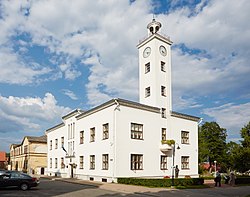Viljandi
| Viljandi | |||
|---|---|---|---|
| Town and municipality | |||

Viljandi town hall
|
|||
|
|||
| Location in Estonia | |||
| Coordinates: 58°22′N 25°36′E / 58.367°N 25.600°ECoordinates: 58°22′N 25°36′E / 58.367°N 25.600°E | |||
| Country |
|
||
| County |
|
||
| Founded | 1263 | ||
| Government | |||
| • Mayor | Ando Kiviberg | ||
| Area | |||
| • Total | 14.62 km2 (5.64 sq mi) | ||
| Elevation | 83 m (272 ft) | ||
| Population (2013) | |||
| • Total | 17 473 | ||
| Ethnicity | |||
| • Estonians | 94% | ||
| • Russians | 3% | ||
| • other | 2.1% | ||
| Time zone | EET (UTC+2) | ||
| • Summer (DST) | EEST (UTC+3) | ||
| Postal code | 71020 | ||
| Area code(s) | (+372) 043 | ||
| Vehicle registration | D | ||
| Website | www.viljandi.ee | ||
Viljandi (Estonian pronunciation: [ˈʋilʲˑjɑnʲˑdi]; German: Fellin) is a town and municipality in southern Estonia with a population of 17,473 in 2013. It is the capital of Viljandi County. The town was first mentioned in 1283, upon being granted its town charter by Wilhelm von Endorpe. The town became a member of the Hanseatic League at the beginning of the 14th century, and is one of five Estonian towns and cities in the league. The once influential Estonian newspaper Sakala was founded in Viljandi in 1878.
The flag of Viljandi is bi-coloured, its upper part light blue and lower part white. The city's shield-shaped coat of arms is light blue, with a white rose in the middle. Viljandi is the white rose city – in midsummer there are 720 white roses flowering in front of the city hall, planted for the town's anniversary in 2003. In summer, the White Rose Day is celebrated in Viljandi.
First records of civilization in the surroundings of Viljandi date back to the 5th millennium B.C. The first written record of the earthen stronghold of Viljandi was in the year 1154 in the commentaries to al-Idrisi's world atlas Geography.
In the 12th century, a permanent settlement emerged around the stronghold of Viljandi, which also became the economic centre of the ancient Sakala district.
In 1211 the hillfort of the Estonians in Viljandi was besieged by a joint army of Germans, Latvians, and Livs. The Livonian Sword Brethren (later the Livonian Order) captured the hillfort in August 1223 from a contingent of the people of Rus, who joined forces with the insurgent Estonians. In place of the Sakala wooden stronghold a powerful Order Centre was started in 1224. The following year the Grand Master Volquin led the construction of the Viljandi Castle at the site of the former hillfort. The Viljandi (Fellin) castle was one of the largest in the Baltic region. It was a major fortification of the Livonian Order and was appointed a commander from 1248. The fortress was continually rebuilt and modernized over the next two-hundred years.
...
Wikipedia



